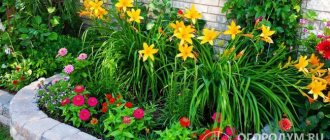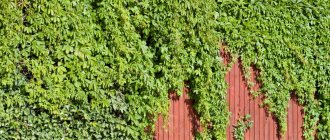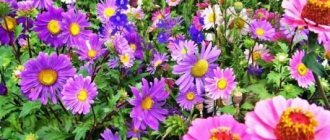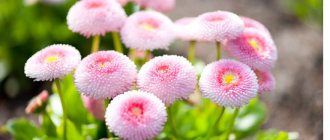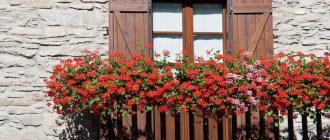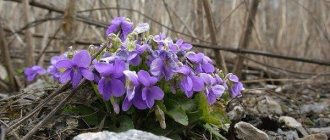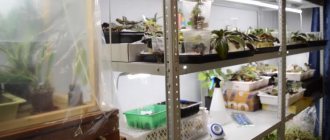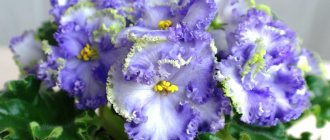If desired, even the darkest corners of the garden can be turned into an attractive summer flower garden. Properly selected compositions of shade-tolerant flowers will delight their owners for several years.
The quality of shade may vary for individual varieties. While some flowers are comfortable on the north side of the site, others remain in bloom longer in partial or lace shade. Ideally, planted crops should replace each other’s blooms, delivering aesthetic pleasure.
Primrose
Wonderful low-growing perennial primrose and its hybrids thrive in the shade. They can grow at the front edge of the flower bed, in the shade of taller, sun-loving flowers. The height of shade-loving primroses is 10 - 20 cm, of various colors. The most interesting types of primroses to grow are auricular ones. Its flowers are double, with various rims. Primrose is difficult to grow at home from seeds, so most often they propagate by dividing old bushes, or purchase new ones. This flower is one of the first to bloom in the garden and delights with its flowering from April to May.
Lungwort
These flowers that love shade are familiar to many from childhood. It is the one that grows in the shade of the forest, and if you taste the bed of the peduncle, it will taste sweet. This is where the name of this color comes from. The leaves of this plant have white spots, the flowers change color from pink to blue. There are varieties with whole green leaves and varied flower colors. Plant height is 30 - 40 cm. It can grow strongly and is classified as ground cover flowers, since the flowers can bush a lot. Lungwort is divided and replanted once every 3 years. Refers to spring flowering plants. Flowering time: April - May.
Shade-loving perennial flowers blooming all summer
Shade-loving perennial flowers for the garden, blooming for a long period, are an excellent solution to decorate an unremarkable area with living plantings. With the help of such crops, you can form original compositions, combine them with stones or other objects of landscape art.
Colorful Foxglove
Foxglove is a two-year, unpretentious representative that can please with long-lasting flowering and thrives in a little shade. The culture produces an incredibly beautiful peduncle (its height is more than 1.5 meters), inside of which there are magical bells.
The colors of the flowers are varied - there can be pink, yellow, purple, red shades. There are also flowers that have rich patterns in the form of dark dots or spots. Flowering is observed almost throughout the entire summer.
Amazing Balsams
Unpretentious blooming shade-loving perennial garden flowers - Impatiens - will help brighten up any unattractive area. Bright flowers in various shades will delight you with their beauty, and prolonged flowering until the first frost will be an additional bonus.
Impatiens are not capricious representatives of the flora, and since they do not tolerate direct sunlight, shady areas are an ideal solution for planting them.
Often, with the help of Balsams, tree trunk circles are decorated and openwork alleys are formed.
Unusual Astrantia
Another shade-loving perennial garden flowers are Astrantia or Zvezdovki. There are about 10 varieties of this crop, most of them prefer to grow in shady areas.
Astrantia is distinguished by straight, weakly branched shoots. The leaves are usually ovoid in shape. Flowering continues throughout the summer, ending only in autumn days.
An additional advantage of the crop is that it is an excellent honey plant, which attracts bees to the garden area. For astrantia, the ideal place would be a ridge, mixborders. Excellent mixes are obtained from astilbe, hosta, and lungwort. In dried form, astrantia is an excellent option for creating bouquets.
Original Mimulus or Lipstick
Excellent perennial representatives that bloom for a long time are mimulus or lipsticks. This is a perennial representative, certain species of which are cultivated in our latitudes.
Bright shrubs can reach up to one and a half meters in height, but herbaceous representatives grow no more than 70 cm. The inflorescences have a racemose shape, the flowers can be spotted or plain. After flowering ends, a box with small brown seeds inside is formed.
With the help of Mimulyunkus, you can form rock gardens in the shade, and crops are also grown in hanging pots.
Everblooming Begonias
If you are interested in what perennial shade-loving flowers to plant on balconies located on the north side, then you simply cannot find a better solution than Begonia.
Many varieties of the crop have good shade tolerance and frost resistance. The main advantage of Begonia is its attractive flowering, which continues throughout the summer. The bushes have a compact shape, their height is no more than 0.2 meters, the leaves can be dark green or reddish brown. Flowers are found in different colors, depending on the variety. The most beloved by gardeners are red, pink and white.
By selecting original perennial shade-loving flowers and shrubs, you will be able to fill every part of your garden plot with incredible beauty. Select the most original cultures and create bright ensembles for a great mood.
Rogersia
It is similar to ornamental rhubarb and can grow in a shady, moist border. The leaves are palmate on long petioles, the flowers without petals are collected in fluffy panicles. It is a perennial and is propagated by dividing bushes in spring or autumn.
These are tall flowers that love shade in the garden, growing up to 1.8 m in height, compact plants up to 1 meter. An excellent plant for decorating country fences and buildings.
Tips for caring for Rogers:
- water abundantly during drought;
- In autumn, cut at the root.
Loosestrife point
Common loosestrife
can grow in one place for up to 10 years. It blooms in July-August for about a month. It grows very quickly and can be an aggressor under favorable conditions. Grows well in damp areas and can tolerate flooding. Forms a beautiful bush. It blooms in July-August with light yellow flowers located along the entire length of the shoot. Can be used near ponds, in mixborders, near fences.
Smilatsina
A border perennial with arched stems crowned with racemes of tiny star-shaped flowers. Fragrant flowers are often replaced by red berries. This is a plant for a wooded corner of the garden that is best left undisturbed. And if you are deciding which flowers grow in shade, and forest-like shade, it is definitely smilacina, which grows quickly, forming beautiful ornamental bushes and creating a soulful landscape design for the area.
The height of the flowers is 60 - 90 cm. The best species for growing in the garden is Smilacina racemosus, which forms large bushes. Flowering period from May to June.
Tips for caring for smilacina:
- shading is required;
- in spring the soil needs to be mulched;
- propagated by dividing bushes in spring.
Shrubs
Some property owners, in order not to spend too much time on flowers, prefer shade-tolerant shrubs to decorate their gardens. Here you first need to decide which ones you need. There are decorative ones that serve solely for aesthetics and beauty. They have carved leaves and large exotic flowers. There are berry plants that will first delight you with flowering and then with fruit.
Decorative:
- common wolfberry;
- privet;
- weigela;
- vineyard;
- wintergreen;
- wisteria;
- Hydrangea paniculata;
- action;
- kalmia;
- leukotoe;
- holly;
- rhododendrons;
- boxwood;
- lilac;
- snowberry;
- spirea;
- stewarty;
- mock orange;
- enkianthus.
Photo:
Berry:
- chokeberry;
- elder;
- blueberry;
- blackberry;
- irga;
- yoshta;
- viburnum;
- dogwood;
- gooseberry;
- raspberries;
- currants white, red, black.
Photo:
It should be borne in mind that not all shade-loving berry bushes will decorate the garden during the flowering period. Most of them have small and inconspicuous flowers. Of course, not all. For example, elderberry and yoshta will compete even with their decorative counterparts.
Tiarella
Above the wintering leaves, which turn bronze or red in the fall, racemose inflorescences of small fluffy flowers rise in the summer. Grows well under trees.
Perennial. Flowering time depends on the species. Tiarella Verri blooms from June to September and does not spread. Tiarella multifolia blooms in May - June. According to the duration of flowering, these are long-blooming flowers. The height of the plants is average, 30 - 50 cm. These garden flowers, blooming in the shade, do not tolerate direct sun and lack of moisture.
There is one feature for all flowers in the shade - all shade-loving flowers need to be planted on humus-rich soil.
How to arrange a flower bed in the shade (partial shade)
A flowerbed is a necessary thing, and it’s nice to have a beautiful corner in your dacha. And where to place it if the plot is only 6 acres and is all planted with trees? The best place for a flowerbed is under trees or in the shade near a fence.
What plants should I plant in the flowerbed?
- Of course ferns. A place near a fence or in the shade of bushes will be just right for them. You can plant primrose and other beautiful flowers near their openwork leaves.
- It is worth paying attention to the ostrich, nomad, and shieldweed. They can also create a beautiful background for other plants.
- The hoof will help to “lay out” the green mat. It will quickly cover all free areas of the flowerbed.
- Hostas, with their richly colored leaves, are the masters of all flower beds; you can’t do without it.
- A scattering of white, blue, and red periwinkle flowers is suitable for a flower bed. Among this scattering you can plant irises.
- Under the trees in the flower bed it will be good for crocuses, blueberries, and anemone. There will be plenty of time to enjoy the spring flowers before the trees begin to leaf out.
- Tiarellas and heucheras can be used as flowerbed borders.
Dicentra
An excellent border perennial and rock garden perennial with a plant height of 30 cm. Wonderful medallion flowers hang from arched peduncles above the feathery foliage. These shade flowers need a protected place to grow: young leaves suffer from cold winds. These flowers can be planted in the shade of trees. Flowering time is from May to June. Color: pink, pinkish-lilac, red.
Dicentra care advice:
- The roots of the plant do not lie deep, so the soil around the stems is not loosened.
Khosta
Hosta is grown for its gorgeous foliage. These are decorative leafy garden flowers in the shade - the pride of any gardener. The foliage has longitudinal stripes of yellowish or white color, bluish-green. Hosta blooms in paniculate inflorescences, with numerous bell-like flowers that bloom in June - August. Grows well in partial shade, under trees. Belongs to border perennials.
Propagated by dividing bushes and nests in the spring. Plant height 50 cm.
Hosta care tip:
- add organic matter before planting;
- the soil where the hosta is planted should be well-drained;
- protect the plant from slugs.
Tips for caring for shade-loving and shade-tolerant plants
It is believed that flowers growing in shaded areas do not require care. Indeed, shade-loving flowers can adapt to the most unfavorable conditions.
Why they need less care:
- In the shade, flower plantings suffer less from drought and wind.
- They are not afraid to burn out in the sun, because it rarely shines on them.
- There is no need to lay mulch underneath them, because the leaves from the trees become mulch and fertilizer.
But shade-loving flowers love to be looked after too. This especially applies to decorative plantings under fruit trees and shrubs.
Flowers planted in the shade of trees need fertilizing and watering so that they do not take away nutrients from the trees.
Flowers for which acidic soil is harmful will not grow in the shade of coniferous trees. Therefore, here it is necessary either to bring the soil back to normal, or to plant perennials that are not averse to growing in acidic soil. Rhododendrons prefer acidic, loose soil, which is where they belong under coniferous plantings.
Lilies of the valley will grow on any soil. Primroses also require almost no care. Only during flowering can they be fed with complex fertilizers and watered.
The charming Rogersia will also require watering. Hydrangea is also not against watering and fertilizing with fertilizers special for it. Ferns love moist soil, so watering is indispensable.
Basically, shade-loving plants do not require care, but in very dry summers they also like watering and loosening.
Violet
There are different types of violets, which are also called pansies. But, if you are choosing a list for the garden, from the category of which flowers bloom in the shade, then you need a perennial violet. This:
- Fragrant violet Viola odorata - 10 - 15 cm. White or blue color. Fragrant. Flowers with a diameter of 2 cm. Blooms in May.
- Horned violet Viola cornuta - 20 cm. Lilac. Blooming all summer from May to September.
- Labrador violet Viola labradorica - 10 cm. Violet - blue. Blooms in spring and early summer.
- Yellow violet Viola lutea and two-flowered Viola biflora - 10 cm. Yellow. Blooms in May - June.
Perennial violets definitely need shade. Faded inflorescences should be removed regularly. The plant is protected from slugs. During drought, watering is necessary.
Impatiens walleriana (Impatiens walleriana)
Impatiens blooms beautifully in shady places. (Waller's impatiens species do well in partial to full shade, but should not be confused with Hawker's impatiens, which require more sun than their variegated cousins. Impatiens tend to wilt dramatically if moisture is insufficient, but usually recover quickly from collapse. when they replenish the lack of water.
Phloxes
There are perennial and annual phloxes. And both types are the kind of flowers that love light shade. They bloom profusely in the second half of summer. Dwarf perennial phlox species are grown in rock gardens.
Phlox blooms in inflorescences of small bell-shaped flowers, the total size of the inflorescences reaches 10 cm in diameter. Flowers with rounded or pointed petals. More popular modern varieties such as Phlox Drummond 'Tapestry Mixed' are more compact and more vibrantly colored than older varieties. The height of perennial plants is 50 - 80 cm, annual phlox reaches 20 - 50 cm.
Phlox care:
- when planting, add organic fertilizers to the soil;
- in spring, the soil around the bushes is mulched;
- if necessary, tie up the stems;
- water moderately;
- at the end of autumn, perennial phloxes need to be cut off at the root.
Astilbe
Feels great in light partial shade on the site. Requires fertile soil. Therefore, before planting astilbe, you need to add organic matter. Spectacular paniculate inflorescences can be left on the bush until autumn. Pinnately dissected leaves often take on a copper tint in spring. During drought, plants need to be watered. There is a drought-resistant species - this is Chinese astilbe.
A fairly tall plant - 90 cm, can grow in the background or middle ground of a flower bed. Used as a border perennial and rock garden perennial. These flowers need to be planted in the shade.
Snowdrop
Bulbous primrose. Small graceful flowers are the harbingers of spring. It blooms in early spring, one of the first in the garden, in April - May.
The snowdrop is similar to the whiteflower, but it has three inner "petals" with green tips, and the outer three are pure white. A low-growing flower, about 15 - 20 cm in height. Loves humus-rich soil and light shade. These lovely flowers need to be planted in the shade.
Strawberries
A shade-loving groundcover plant grown for its flowers and berries. The characteristic trifoliate leaves can decorate a shady garden and create an atmospheric corner.
Strawberries grow quickly and can choke out weaker plants. It blooms in May - June, and the delicious and fragrant berries ripen at the end of June - July. Suitable for creating a herb garden. Plant height 10 cm - 20 cm.
Aquilegia
Aquilegia
A plant that can amaze anyone with its variety of species and shades. It blooms in June, but when the faded flower stalks are removed, it is capable of re-blooming. I also really like the foliage of Aquilegia. A bright bush of openwork leaves is decorative even outside the flowering period. Small aquilegia flowers are distinguished by their original shape, delicate shades and discreet charm. Aquilegia can give a shady flower garden a completely different sound, transforming it into the bright palette of an artist.
Related article: Aquilegia: growing and caring for perennials for the garden
catchment area
Traditional columbines have white or blue flowers with short spurs. Nowadays varieties with long spurs, double varieties, and also dwarf ones for rock gardens have been bred.
These are flowers that love shade and bloom in the shade in the first half of summer, from May to June. For long-term flowering, you need to remove faded flowers and water abundantly during drought. They grow well in constantly moist and shady places.
They reproduce by seeds, which can be sown directly into open ground in the spring or by dividing overgrown perennial bushes.
Caladium (Caladium bicolor)
With spray-painted leaves, shaped like arrowheads, and a height not exceeding half a meter. Caladiums are a great solution when it comes to decorating dark corners of the garden. Also called angel wings, most caladiums prefer partial to full shade. Because they grow well at temperatures above 15°C, they are best grown in warm climates.
Pet owners, beware: caladium is toxic to both cats and dogs.
Day-lily
Blooming in light shade, these flowers appear in midsummer, above rosettes of strap-shaped leaves on long stalks. Each flower lives only 1 day, but the flowering communication of the plant continues for many weeks.
An unpretentious, easy to grow plant. Requires watering during drought, can grow along the banks of reservoirs and along the house. Plant height is 90 cm. Flower color is yellow, orange, dark red. A perennial plant that reproduces by dividing bushes.
Begonia everblooming and begonia species with tubers
Begonia is an ever-blooming plant, usually grown as an annual that grows well in partial shade. The color of the round, fleshy leaves varies from pale green to chocolate brown. The size of flowers can vary from 2 to 15 cm. Color from white to almost black. When planting begonias, add compost to the beds. Planted at the end of June (not in May!) Begonia blooms, which loves shade from June to September.
Ivy
Almost every summer cottage could use climbing plants for the north side of the house. It is here that a deep shadow forms, little grows, and despite this, I really want to green up this particular part of the lot. There are not many climbing plants that can be planted on the north side of the house and they will do well there. This is exactly what the unpretentious evergreen vine, ivy, belongs to. Ivy does not harm trees or buildings and can grow wildly.
Peculiarities
The main differences between shade-loving flowers and all others:
- unpretentious (the owner of the site can safely go somewhere for 2-3 weeks, and they definitely won’t die without him);
- feel great without sunlight;
- tolerate high humidity (both air and soil);
- grow wildly and abundantly;
- adapt to shade - have lush, dark green foliage (most often) and bright flowers.
Shade-loving flowers can be distinguished from all others even by their appearance. They are usually given away by the leaves:
- dark green;
- large, wide;
- thin, soft, plastic;
- flat, smooth;
- under the influence of light they fade, become lighter, and become covered with spots that indicate sunburn;
- horizontal and mosaic arrangement of foliage.
The stem is tall and elongated. The flowers themselves can be small or large, but their color palette most often amazes with its brightness and variety.
